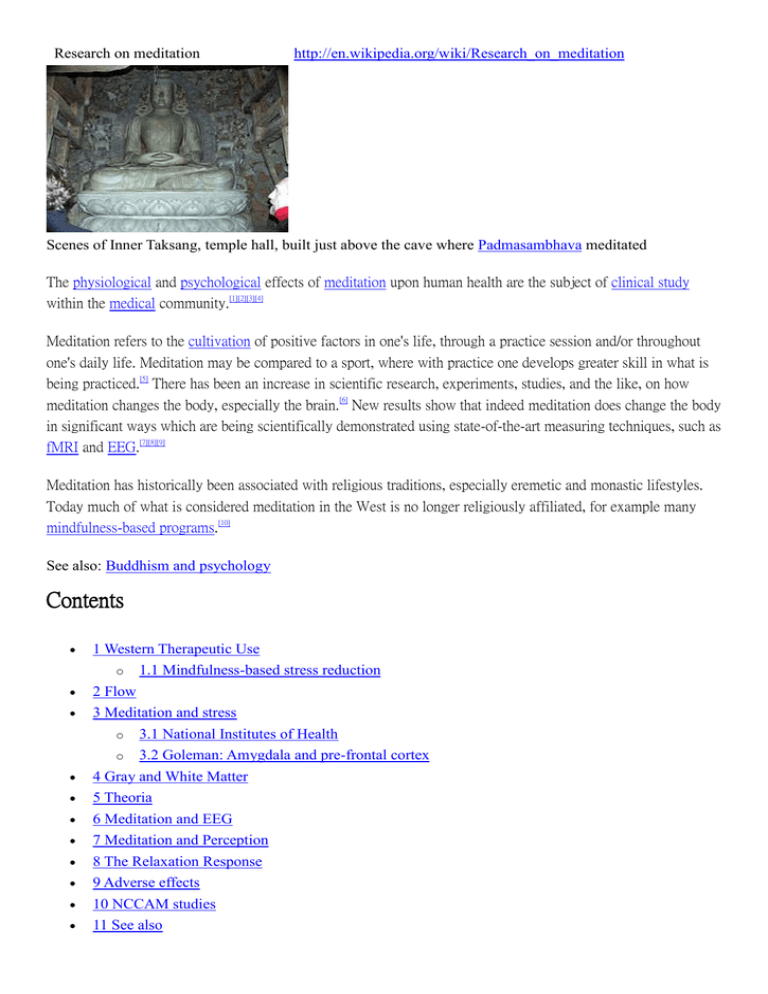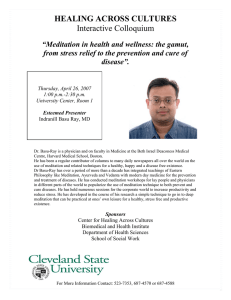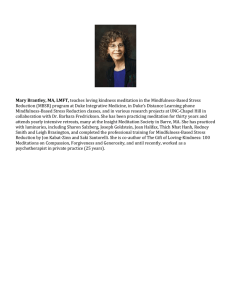Research on meditation Padmasambhava
advertisement

Research on meditation http://en.wikipedia.org/wiki/Research_on_meditation Scenes of Inner Taksang, temple hall, built just above the cave where Padmasambhava meditated The physiological and psychological effects of meditation upon human health are the subject of clinical study within the medical community.[1][2][3][4] Meditation refers to the cultivation of positive factors in one's life, through a practice session and/or throughout one's daily life. Meditation may be compared to a sport, where with practice one develops greater skill in what is being practiced.[5] There has been an increase in scientific research, experiments, studies, and the like, on how meditation changes the body, especially the brain.[6] New results show that indeed meditation does change the body in significant ways which are being scientifically demonstrated using state-of-the-art measuring techniques, such as fMRI and EEG.[7][8][9] Meditation has historically been associated with religious traditions, especially eremetic and monastic lifestyles. Today much of what is considered meditation in the West is no longer religiously affiliated, for example many [10] mindfulness-based programs. See also: Buddhism and psychology Contents 1 Western Therapeutic Use o 1.1 Mindfulness-based stress reduction 2 Flow 3 Meditation and stress o 3.1 National Institutes of Health o 3.2 Goleman: Amygdala and pre-frontal cortex 4 Gray and White Matter 5 Theoria 6 Meditation and EEG 7 Meditation and Perception 8 The Relaxation Response 9 Adverse effects 10 NCCAM studies 11 See also 12 References 13 External links Western Therapeutic Use Meditation has entered the mainstream of health care as a method of stress and pain reduction. As a method of stress reduction, meditation has been used in hospitals in cases of chronic or terminal illness to reduce complications associated with increased stress that include depressed immune systems. There is growing agreement in the medical community that mental factors such as stress significantly contribute to a lack of physical health, and there is a growing movement in mainstream science to fund research in this area. There are now several mainstream health care programs which aid those, both sick and healthy, in promoting their inner well-being, especially those mindfulness based programs. Mindfulness-based stress reduction See also: Mindfulness (psychology) and Mindfulness-based stress reduction A 2003 meta-analysis found that mindfulness-based stress reduction, which involves continuous awareness of consciousness, without seeking to censor thoughts, concluded that the form of meditation may be broadly useful for individuals attempting to cope with clinical and nonclinical problems. Diagnoses for which MBSR was found to be helpful included chronic pain, fibromyalgia, cancer patients and coronary artery disease. Improvements were noted for both physical and mental health measures.[11] Flow Mindfulness meditation, anapanasati, and related techniques, are intended to train attention for the sake of provoking insight. A wider, more flexible attention span makes it easier to be aware of a situation, easier to be objective in emotionally or morally difficult situations, and easier to achieve a state of responsive, creative awareness or "flow".[12] Research from Harvard medical school also shows that during meditation, physiological signals show that there is a decrease in respiration and increase in heart rate and blood oxygen saturation levels.[13] Meditation and stress National Institutes of Health According to the National Institutes of Health (NIH), "Practicing meditation has been shown to induce some changes in the body...Some types of meditation might work by affecting the autonomic (involuntary) nervous system." The sympathetic nervous system and parasympathetic nervous system are two divisions of the autonomic nervous system of the body. The sympathetic nervous system is responsible for our reaction to stress or fear and is colloquially known as the "fight-or-flight" system. The parasympathetic nervous system is active during times of rest and associated with "rest and digest". The NIH goes on, "It is thought that some types of meditation might work by reducing activity in the sympathetic nervous system and increasing activity in the parasympathetic nervous system." Goleman: Amygdala and pre-frontal cortex One theory, presented by Daniel Goleman & Tara Bennett-Goleman[14] suggests that meditation[clarification needed] works because of the relationship between the amygdala and the prefrontal cortex.[15] In very simple terms, the amygdala is the part of the brain that decides if we should get angry or anxious (among other things), and the pre-frontal cortex is the part that makes us stop and think about things (it is also known as the inhibitory centre). The prefrontal cortex is very good at analyzing and planning, but it takes a long time to make decisions. The amygdala, on the other hand, is simpler (and older [16] in evolutionary terms). It makes rapid judgments about a situation and has a powerful effect on our emotions and behaviour, linked to survival needs. For example, if a human sees a lion leaping out at them, the amygdala will trigger a fight or flight response long before the prefrontal cortex responds. But in making snap judgments, our amygdalas are prone to error[citation needed], such as seeing danger where there is none.[citation needed] This is particularly true in contemporary society where social conflicts are far more common than encounters with predators, and a basically harmless but emotionally charged situation can trigger uncontrollable fear or anger — leading to conflict, anxiety, and stress.[17] Gray and White Matter Studies done by Yale, Harvard, Massachusetts General Hospital have shown that meditation increases gray matter in the brain and slows down the deterioration of the brain as a part of the natural aging process. The experiment included 20 individuals with intensive Buddhist "insight meditation" training and 15 who did not meditate. The brain scan revealed that those who meditated have an increased thickness of gray matter in parts of the brain that are responsible for attention and processing sensory input. The increase in thickness ranged between .004 and .008inches (3.175 x 10−6m - 6.35 x 10 −6m) and was proportional to the amount of meditation. The study also showed that meditation helps slow down brain deterioration due to aging.[18][19] A study involving the participation of a group of colleges students, who were asked to use a meditation technique called integrative body-mind training, concluded that "meditating may improve the integrity and efficiency of certain connections in the brain" through an increase in their number and robustness[20] Brain scans showed strong white matter changes in the anterior cingulate cortex.[21] Dr. James Austin, a neurophysiologist at the University of Colorado, reported that meditation in Zen "rewires the circuitry" of the brain in his book Zen and the Brain (Austin, 1999). This has been confirmed using functional MRI imaging, a brain scanning technique that measures blood flow in the brain.[citation needed] Theoria Fifteen Carmelite nuns came from the monastery to the laboratory to enter a fMRI machine whilst meditating, allowing scientists there to scan their brains using fMRI while they were in a state known as Unio Mystica (and also Theoria).[22] The results showed that far-flung parts of the brain were recruited in the sustaining of this mystical union with God.[22] During a meditation test, using fMRI two states were compared. Activity during the last 6 minutes of meditation and activity during 6 minutes of controlled meditation. As a result, in the controlled analysis increases were found in putamen, midbrain, pregenual anterior cingulate cortex and hippocampal/parahippocampal formation. However, in the last 6 minutes multiple foci of activation within prefrontal, parietal and temporal cortices as well as in the precentral and postcentral gyri, and hippocampal/parahippocampal formation were identified. The article [23] shows activation during meditation. The prompt values were analyzed at the Mind-Body Medical Institute. Meditation and EEG Electroencephalograph (EEG) recordings of skilled meditators showed a significant rise in gamma wave activity in the 80 to 120Hz range during meditation. There was also a rise in the range of 25 to 42Hz. These meditators had 10 to 40 years of training in Buddhist-based mental[clarification needed] training. EEG done on meditators who had received recent training demonstrated considerably less rise.[24] The experienced meditators also showed increased gamma activity while at rest and not meditating.[24] During meditation there is a modest increase in slow alpha or theta wave EEG activity.[24][25] Chang and Lo found different results, explicable perhaps by the fact they show no sign of even having tested for gamma.[26] First they classify five patterns in meditation based on the normal four frequency ranges (delta < 4Hz, theta 4 to <8Hz, alpha 8 to 13Hz, and beta >13Hz). The five patterns they found were: 1) delta 2) delta + theta 3) theta + slow alpha 4) high-amplitude alpha 5) amplitude suppressed ("silent and almost flat") They found pattern #5 unique and characterized by: 1) extremely low power (significant suppression of EEG amplitude) 2) corresponding temporal patterns with no particular EEG rhythm 3) no dominating peak in the spectral distribution They had collected EEG patterns from more than 50 meditators over the prior five years. Five meditation EEG scenarios are then described. They further state that most meditation is dominated by alpha waves. They found delta and theta waves occurred occasionally, sometimes while people fell asleep and sometimes not. In particular they found the amplitude suppressed pattern correlated with "the feeling of blessings." O Nuallain,Sean (2009) [27] in Cognitive Sciences 4(2), is the first to interrelate the work on synchronized gamma in consciousness with the well-attested work on gamma in meditation in an experimental context. It adduces experimental and simulated data to show that what both have in common is the ability to put the brain into a state in which it is maximally sensitive and consumes power at a lower (or even zero) rate, briefly. It is argued that this may correspond to a “selfless” state and the more typical non-zero state, in which gamma is not so prominent, corresponds to a state of empirical self. Thus, the “zero power” in the title refers not only to the power spectrum of the brain as measured by the Hilbert transform, but also to a psychological state of personal renunciation. Meditation and Perception Studies have shown that meditation has both short-term and long-term effects on various perceptual faculties. In 1984, Brown et al. conducted a study that measured the absolute threshold of perception for light stimulus duration in practitioners and non-practitioners of mindfulness meditation. The results showed that meditators have a significantly lower detection threshold for light stimuli of short duration.[28] In 2000, Tloczynski et al. studied the perception of visual illusions (the Müller-Lyer Illusion and the Poggendorff Illusion) by zen masters, novice meditators, and non-meditators. There were no statistically significant effects found for the Müller-Lyer illusion, however, there were for the Poggendorff. The zen masters experienced a statistically significant reduction in initial illusion (measured as error in millimeters) and a lower decrement in illusion for subsequent trials.[29] The theory of mechanism behind the changes in perception that accompany mindfulness meditation is described thus by Tloczynski: “A person who meditates consequently perceives objects more as directly experienced stimuli and less as concepts… With the removal or minimization of cognitive stimuli and generally increasing awareness, meditation can therefore influence both the quality (accuracy) and quantity (detection) of perception.”[cite this quote] Brown also points to this as a possible explanation of the phenomenon: “[the higher rate of detection of single light flashes] involves quieting some of the higher mental processes which normally obstruct the perception of subtle events.” In other words, the practice may temporarily or permanently alter some of the top-down processing involved in filtering subtle events usually deemed noise by the perceptual filters. The Relaxation Response Dr. Herbert Benson of the Mind-Body Medical Institute, which is affiliated with Harvard University and several Boston hospitals, reports that meditation induces a host of biochemical and physical changes in the body collectively referred to as the "relaxation response."[30] The relaxation response includes changes in metabolism, heart rate, respiration, blood pressure and brain chemistry. Benson and his team have also done clinical studies at Buddhist monasteries in the Himalayan Mountains.[citation needed] Adverse effects The following is an official statement from the US government-run National Center for Complementary and Alternative Medicine: Meditation is considered to be safe for healthy people. There have been rare reports that meditation could cause or worsen symptoms in people who have certain psychiatric problems, but this question has not been fully researched. People with physical limitations may not be able to participate in certain meditative practices involving physical movement. Individuals with existing mental or physical health conditions should speak with their health care providers prior to starting a meditative practice and make their meditation instructor aware of their condition.[31] Both positive rewards and potential benefits of meditation have been noted in academic literature. Adverse effects [32] [33] have been reported, and may, in some cases, be the result of "improper use of meditation". The NIH advises prospective meditators to "ask about the training and experience of the meditation instructor... [they] are considering."[31] Kundalini syndrome is a claimed adverse effect from practicing Kundalini Yoga. As with any practice, meditation may also be used to avoid facing ongoing problems or emerging crises in the meditator's life. In such situations, it may be helpful to apply mindful attitudes acquired in meditation while actively engaging with current problems.[34] According to the NIH, meditation should not be used as a replacement for conventional health care or as a reason to postpone seeing a doctor.[31] NCCAM studies A comparison of the effect of various meditation techniques on systolic blood pressure.[35] In June, 2007 the United States National Center for Complementary and Alternative Medicine (NCCAM) published an independent, peer-reviewed, meta-analysis of the state of meditation research, conducted by researchers at the University of Alberta Evidence-based Practice Center. The report reviewed 813 studies involving five broad categories of meditation: mantra meditation, mindfulness meditation, yoga, Tai Chi, and Qi Gong, and included all studies on adults through September 2005, with a particular focus on research pertaining to hypertension, cardiovascular disease, and substance abuse. The report concluded, "Scientific research on meditation practices does not appear to have a common theoretical perspective and is characterized by poor methodological quality. Firm conclusions on the effects of meditation practices in healthcare cannot be drawn based on the available evidence. Future research on meditation practices must be more rigorous in the design and execution of studies and in the analysis and reporting of results." (p.6) It noted that there is no theoretical explanation of health effects from meditation common to all meditation techniques.[36] A further analysis of this data set in 2008 reaffirmed the weaknesses of the research, finding that "Most clinical trials on meditation practices are generally characterized by poor methodological quality with significant threats to validity in every major quality domain assessed". This was the conclusion despite a statistically significant increase in quality of all reviewed meditation research, in general, over time between 1956-2005. Of the 400 clinical studies, 10% were found to be good quality. A call was made for rigorous study of meditation.[37] These authors also noted that this finding is not unique to the area of meditation research and that the quality of reporting is a frequent problem in other areas of complementary and alternative medicine (CAM) research and related therapy research domains. In 2006 NCCAM revised their definition of meditation, emphasizing the experience of the “suspension of thought activity". This definition led to the possibility of comparing mental silence oriented meditation with resting alone and one study found significant physiological differences between the two.[38] See also Meditation Buddhist meditation Transcendental Meditation research References 1. ^ Venkatesh S, Raju TR, Shivani Y, Tompkins G, Meti BL. (1997) A study of structure of phenomenology of consciousness in meditative and non-meditative states. Indian J Physiol Pharmacol. 1997 Apr;41(2): 149–53. PubMed Abstract PMID 9142560 2. ^ Peng CK, Mietus JE, Liu Y, Khalsa G, Douglas PS, Benson H, Goldberger AL. (1999) Exaggerated heart rate oscillations during two meditation techniques. Int J Cardiol. 1999 Jul 31;70(2):101–7. PubMed Abstract PMID 10454297 3. ^ Lazar, S.W.; Bush, G.; Gollub, R. L.; Fricchione, G. L.; Khalsa, G.; Benson, H. Functional brain mapping of the relaxation response and meditation" NeuroReport: Volume 11(7) 15 May 2000 pp. 1581–1585 PubMed abstract PMID 10841380 4. ^ Carlson LE, Ursuliak Z, Goodey E, Angen M, Speca M. (2001) The effects of a mindfulness meditation-based stress reduction program on mood and symptoms of stress in cancer outpatients: 6-month follow-up. Support Care Cancer. 2001 Mar;9(2):112-23.PubMed abstract PMID 11305069 5. ^ "Train Your Mind Change Your Brain" by Sharon Begley pages 229-242, in the chapter "Transforming the Emotional Mind" 6. ^ There has been a dramatic increase in the past 10 or 15 years or so of studies on the impact of meditation upon one's health. Translator for The Dalai Lama, interviewed in a video here 7. ^ Davidson, Richard J.; Kabat-Zinn J, Schumacher J, Rosenkranz M, Muller D, Santorelli SF, Urbanowski F, Harrington A, Bonus K, Sheridan JF. (2003 Jul-Aug). "Alterations in brain and immune function produced by mindfulness meditation". Psychosomatic Medicine 65 (4): 564–570. doi:10.1097/01.PSY.0000077505.67574.E3. PMID 12883106. 8. ^ Physiological Effects of Transcendental Meditation by Wallace @ http://www.sciencemag.org/cgi/content/abstract/167/3926/1751 published in 1970! 9. ^ Kabat-Zinn, Jon; Lipworth L, Burney R. (1985). "The clinical use of mindfulness meditation for the self-regulation of chronic pain". Journal of Behavioral Medicine 8 (2): 163–190. doi:10.1007/BF00845519. PMID 3897551. 10. ^ The following was taken from MBSR... "Jon Kabat-Zinn has said that his program has nothing at all to do with Buddhism, it is not spiritually based, and is therefore open to everyone no matter what life circumstances they are in.[reference-> In this video Jon Kabat-Zinn can be seen giving a speech at Google Headquarters about mindfulness, including the benefits shown by scientific study, the practice and principles of mindfulness, and how it relates to modern life in general http://www.youtube.com/watch?v=rSU8ftmmhmw Mindfulness-based stress] MBSR is practiced by those old and young, sick and healthy, professionals and monks alike. Jon Kabat-Zinn has also said that the principles of mindfulness, on which MBSR is based, have been most clearly articulated by those in Buddhist traditions.[reference-> In this video Jon Kabat-Zinn can be seen giving a speech at Google Headquarters about mindfulness, including the benefits shown by scientific study, the practice and principles of mindfulness, and how it relates to modern life in general http://www.youtube.com/watch?v=rSU8ftmmhmw Mindfulness-based stress][reference->Jon also has said this in his 2 cd talk called "Mindfulness for Beginners"] Today mindfulness has gained widespread practice in the medical community, and has many modern applications in health science. 11. ^ Grossman, P.; Niemann, L.; Schmidt, S.; Walach, H. (2004). "Mindfulness-based stress reduction and health benefitsA meta-analysis" (pdf). Journal of Psychosomatic Research 57 (1): 35–43. doi:10.1016/S0022-3999(03)00573-7. PMID 15256293. http://www.epilepsiezentrum.uniklinik-freiburg.de/medmed/live/literatur/MBSR_MA_JPR_2004.pdf. Retrieved 2010-07-07. edit 12. ^ .ref name="flow">Commentary: In the Zone: A Biobehavioral Theory of the Flow Experience 13. ^ .ref name="flow">Functional brain mapping of the relaxation response and meditation 14. ^ Bennett-Goleman, Tara, 2001. Emotional Alchemy: How the Mind can Heal the Heart, Harmony, 1st Edition: Jan 9, 2001, ISBN 978-0609607527 15. ^ The Emotionally Intelligent Workplace, Chapter Three 16. ^ Sagan, Carl. The Dragons of Eden; Random House, New York. 1977 17. ^ Social Anxiety and Social Phobia:Symptoms, Treatment and Support 18. ^ Harvard University Gazette: Meditation found to increase brain size 19. ^ Meditation Associated With Increased Grey Matter In The Brain 20. ^ "Meditation boosts part of brain where ADD, addictions reside". Ars Technica. http://arstechnica.com/science/news/2010/08/meditation-boosts-part-of-brain-where-add-addictions-reside.ars. Retrieved 2010-08-22. 21. ^ "Integrative body-mind training (IBMT) meditation found to boost brain connectivity". ScienceDaily. http://www.sciencedaily.com/releases/2010/08/100816155000.htm. Retrieved 2010-08-22. 22. ^ a b M. Beauregard & V. Paquette (2006). "Neural correlates of a mystical experience in Carmelite nuns". Neuroscience Letters (Elsevier) 405 (3): 186–90. doi:10.1016/j.neulet.2006.06.060. ISSN 0304-3940. PMID 16872743. 23. ^ .ref name="flow">Functional brain mapping of the relaxation response and meditation 24. ^ a b c Lutz, Antoine. "Breakthrough study on EEG of meditation". http://www.quantumconsciousness.org/EEGmeditation.htm. Retrieved 2006-08-14. 25. ^ Bhattathiry, M.P.. "Neurophysiology of Meditation". http://1stholistic.com/Meditation/hol_meditation_neurophysiology-of-meditation.htm. Retrieved 2006-08-14. 26. ^ Chang, Kanf-Ming (2005-07-15). "Meditation EEG Interpretation based on novel fuzzy-merging strategies and wavelet features". http://bme.ntu.edu.tw/abc/17.4/17-4-2.pdf. Retrieved 2006-08-14. 27. ^ O'Nuallain, Sean. "Zero Power and Selflessness: What Meditation and Conscious Perception Have in Common". https://www.novapublishers.com/catalog/product_info.php?products_id=10068. Retrieved 2009-05-30. 28. ^ Brown, Daniel, et al. "Differences in Visual Sensitivity Among Mindfulness Meditators and Non-Meditators". Perceptual and Motor Skills 1984: 727-733. 29. ^ Tloczynski, Joseph, et al., "Perception of Visual Illusions by Novice and Longer-Term Meditators". Perceptual and Motor Skills 2000: 1021-1027. 30. ^ Benson, H., "The relaxation response: therapeutic effect," Science. 1997 Dec 5;278(5344):1694-5. PMID: 9411784 31. ^ a b c Meditation: An Introduction on the National Center for Complementary and Alternative Medicine's webpage, NCAAM is a subdivision of NIH. http://nccam.nih.gov/health/meditation/overview.htm#meditation 32. ^ From a clinical study of twenty-seven long term meditators, Shapiro found that subjects reported significantly more positive effects than negative from meditation. However, of the twenty-seven subjects, seventeen (62.9%) reported at least one adverse effect, and two (7.4%) suffered profound adverse effects. Among these we find: relaxation-induced anxiety and panic; paradoxical increases in tension; less motivation in life; boredom; pain; impaired reality testing; confusion and disorientation; feeling 'spaced out'; depression; increased negativity; being more judgmental; and, ironically, feeling addicted to meditation Shapiro 1992, cited in Perez-De-Albeniz, Alberto and Holmes, Jeremy. Meditation: concepts, effects and uses in therapy. International Journal of Psychotherapy, Mar 2000, Vol. 5 Issue 1, p49, 10p 33. ^ Turner, Robert P.; Lukoff, David; Barnhouse, Ruth Tiffany & Lu, Francis G. Religious or Spiritual Problem. A Culturally Sensitive Diagnostic Category in the DSM-IV. Journal of Nervous and Mental Disease, 1995; Vol.183, No. 7 435-444. Page 440. 34. ^ Hayes, 1999, chap. 3; Metzner, 2005 35. ^ Ospina p.130 36. ^ Ospina MB, Bond TK, Karkhaneh M, Tjosvold L, Vandermeer B, Liang Y, Bialy L, Hooton N,Buscemi N, Dryden DM, Klassen TP. "Meditation Practices for Health: State of the Research". Evidence Report/Technology Assessment No. 155. (Prepared by the University of Alberta Evidence-based Practice Center under Contract No. 290-02-0023.) AHRQ Publication No. 07-E010. Rockville, MD: Agency for Healthcare Research and Quality. June 2007. 37. ^ Ospina MB, Bond K, Karkhaneh M, et al. (December 2008). "Clinical trials of meditation practices in health care: characteristics and quality". J Altern Complement Med 14 (10): 1199–213. doi:10.1089/acm.2008.0307. PMID 19123875. 38. ^ Manocha R, Black D, Ryan J, Stough C, Spiro D, [1] "This study demonstrates a skin temperature reduction on the palms of the hands during the experience of mental silence, arising as a result of a single 10 minute session of Sahaja yoga meditation." [Changing Definitions of Meditation: Physiological Corollorary, Journal of the International Society of Life Sciences, Vol 28 (1), Mar 2010] External links Meditation Practices for Health: State of the Research Agency for Healthcare Research and Quality This page was last modified on 14 June 2011 at 10:14.



